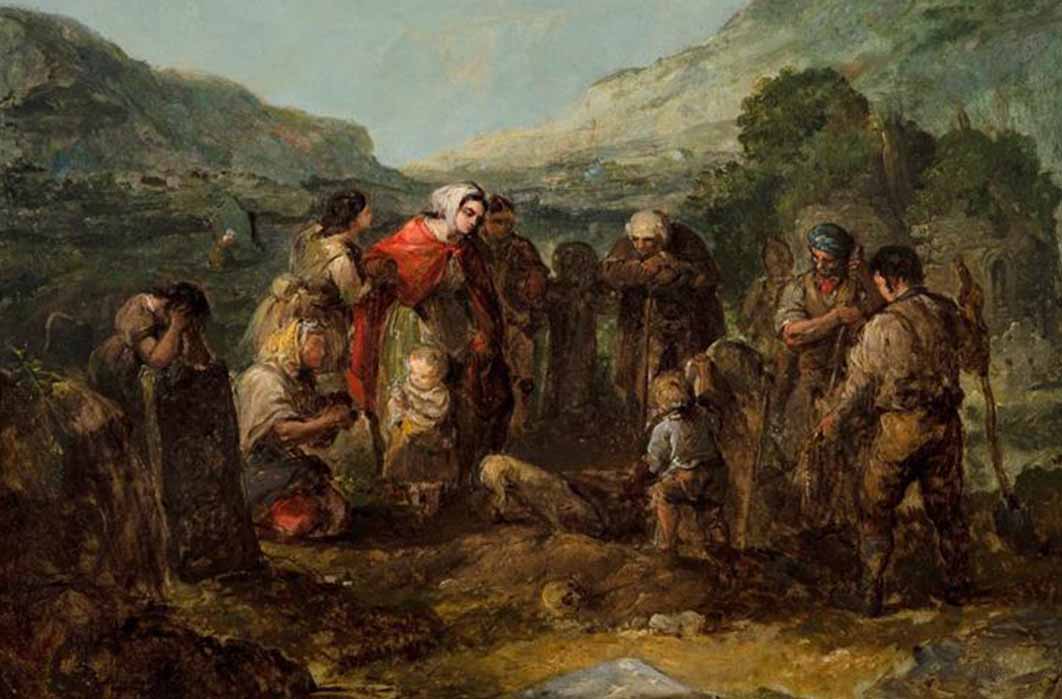
Howling The Horror Of Loss: Keening And Death Lament Of The Irish
“Bríg came and keened for her son. At first she shrieked, in the end she wept. Then for the first time weeping and lamentation were heard in Ireland.” The quotation comes from the ancient Irish text, Lebor Gabála Érenn, or The Book of Invasions, and describes what has been referred to as the first keening cry heard in Ireland. Brigid, seeing her dead son, is overcome by grief and begins to wail and cry in what would become a keen. The term ‘keening’ originates from the Gaelic caoineadh which means ‘to cry’.

The Aran Fisherman's Drowned Child by Frederic William Burton, which appears to show paid keening women in the doorway (1851)(Public Domain)
Keening A Safe Passage
Keening, to give an initial simple description, is a form of death wailing usually expressed by women which is found in many indigenous cultures stretching from Europe to the Americas and throughout Australia, Africa and Asia. In certain traditions keening takes the form of wordless cry, and becomes an emotional outpouring of sounds, but in a diversification there is very often a recounting of the deceased person’s deeds and traits. This might be a plea to the spirit world or deities to look kindly upon the departed person, but there was also an honoring aspect to these incantations and an attempt to sing a scar upon the memory of those left behind in order to never forget what they had lost.
In ancient Greece, mourners called Goetes would howl and chant next to the dead person in order to secure safe passage for their soul to the heavenly realms. The term 'Goetes' is sometimes said to mean 'sorcerer' or 'magician', but its original translation was more accurately conveyed as to 'moan' or 'howl'.
Although the term 'shamanistic' is often used outside of the original cultural context, in this instance there is a direct relationship to the Asian forms of chanting and singing at the funerals of the dead. It is possible to trace many of the practices of appeasing ghosts, for example, from Asia to Mesopotamia and onto Greece. It was believed that these shamanistic-type 'songs' somehow attached to or carried the soul of the dead person and helped to navigate its way past the obstacles and dangers of the Underworld. The inclusion of heroic deeds or acts of kindness or charity in the chants would add further weight to the deceased persons chances of appeasing the ancestors and spirits.

Bunworth Banshee, Fairy Legends and Traditions of the South of Ireland by Thomas Crofton Croker, (1825) (Public Domain)
Keening At An Irish Wake
In this Irish example of keening there is a particular trait of praising the deceased person. According to the National Folklore Collection: “Long ago when a person died the old women of the neighborhood would come into the wake house crying over the corpse and reciting the praises of the dead man or woman. This would generally be repeated from time to time until the corpse was taken to be buried..."
From an Irish context, keening, which was once an integral part of the Irish grieving process, began to vanish by the 1880’s. In many academic papers it is implied that keening was strong until the mid-20th century but the availability of Irish folklore archives from the mid-20th century contradicts this view.
According to the scholar, Angela Bourke, the Irish famine also played a role in the demise of keening in that it was often the rural poor who kept older traditions intact. With the famine having such a devastating impact upon the poorer classes, as well as mass emigration, these factors would have broken many lineages where keening had been passed down.
The Cry Of The Banshee
In the following example from Co. Tipperary, collected in 1938, the keening women are also described as combing their hair which connects these mournful wails to the actions of the Irish fairy woman, the Bean Sídhe: "In olden times when a person died the relatives of the dead person went several miles to get a "keener", 'caoinear'. This was a woman who went to the side of the bed and kept keening or crying until the person was buried. The keeners are not called to my district when wakes take place, but some of them visit the houses of the dead persons still and start keening outside the windows. While the keeners are keening outside, they keep combing their hair."




